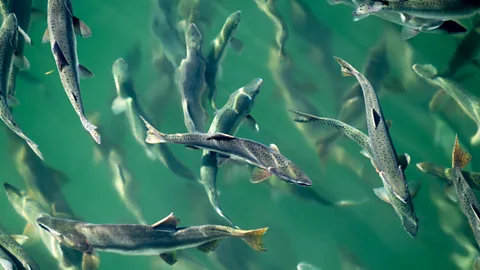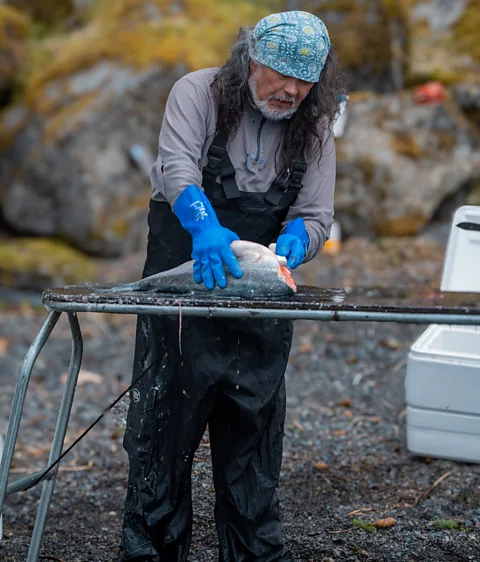Warming rivers and over-fishing leave native Alaskans facing 'salmon scarcity'
 Della Stroh
Della StrohAs the Earth's rivers warm, salmon must either struggle to survive in a degraded habitat or move to cooler waters – but native Alaskan fishing practices are helping protect them.
Ocean heatwaves have been well documented in recent years. Now, scientists say river temperatures, too, are soaring – leaving Alaska's world-famous salmon to navigate increasingly challenging waters as they struggle to complete their migratory cycle. When circumstances deteriorate, migrating fish are often forced to keep moving until they find cooler water. Now, changes in salmon populations are already affecting the culture and lifestyle of many coastal native tribes, a connection that goes back thousands of years.
Salmon are anadromous fish, meaning they spend parts of their lives in different habitats. Alaska's rivers are home to all five species of Pacific salmon; pink (humpy), chinook (king), coho (silver), sockeye (red) and chum (dog). Although there are differences between them, they are all born in freshwater and spend some time there before heading to the ocean, which has better resources for them to eat and grow. When ready, they return to the same stream they were born in, to reproduce and then die.
Salmon go back to their home river because it usually gives them the best chance of survival, says Peter Westley, associate professor of fisheries at the University of Alaska Fairbanks. "Different rivers have different factors, like temperature and how much water is in it, and how big the rocks are – all kinds of stuff. So, the fish that were born there and survived there have traits that allow them to do well there."
 Linda Infante Lyons
Linda Infante LyonsHowever, salmon are also very temperature-sensitive and there is growing evidence that some are veering to cooler habitats. Westley led a research project that confirmed salmon are increasingly spawning in Arctic rivers, a region which had previously been too cold. This suggests that at least some salmon species, in this case chum, could be venturing into new territory as climate change reshapes their environment. Similarly, a more recent study found a significant shift in the migratory patterns of Pacific salmon; namely a northward movement into the western Canadian Arctic as it gets warmer.
However, rising temperatures are affecting salmon species differently across the regions of Alaska. While some are working their way north, other populations are severely declining. "In some southern parts of Alaska, it's getting so warm that salmon are really struggling with heat stress and are dying," says Westley.
Although fish can, in theory, find better conditions elsewhere, it doesn't always happen. "Migrations are costly. If you're going to travel, it puts you at risk of being eaten by predators and you're burning energy to swim longer distances. It's difficult for a fish to just go somewhere else," says Westley. "And if you go too far north, there's not as much food, so there are real trade-offs for fish that are migrating."
 Della Stroh
Della StrohThis trend is not endemic to Alaska, and although climate change is affecting habitats, it is not the only culprit. A 2024 global study by the World Fish Migration Foundation found an average of 81% decline in migratory freshwater fish populations between 1970 and 2020. Due to data limitations, the situation might be even worse. The report states that migratory fishes are disproportionately threatened, especially those that spend parts of their life in freshwater, largely due to overfishing, and habitat loss or degradation.
One of the places most affected by salmon declines is along the Yukon River, Alaska's largest watershed which originates in the coastal mountains of Canada and flows 1,979 miles (3,184km) in a wide arc to the Bering Sea (where approximately 40% of the US commercial fishery catch comes from).
Eva Dawn Burk, from the Nenana native village grew up on a fish camp along the Yukon River with her nomadic family, who subsistence harvest and commercially fish. In a fish camp, native families put their net or fish wheel in the rivers, build smokehouses, set up drying racks and process salmon, a tradition that goes a long way back. Her background was in engineering, working in oil and gas pipelines, but Burk now specialises in natural resources and environment. She is trying to reconnect with their traditional indigenous way of life, and campaigning for food security and food sovereignty.
Most villages on the Yukon are only accessible by plane or boat, which elevates the cost of importing food sources. Salmon is a crucial part of native people's culture and diet, especially those living along rivers, and who have depended on wild salmon for thousands of generations.
"You have so much respect for living beings as a native person. I look at salmon as my ancestors, and then as my children and grandchildren. The salmon relatives and my relatives have been living in relation for all these years," says Burk.
But locals have been facing severe salmon scarcity. "This will be the fifth year of not fishing," she says. "We had a lot of heat stress in 2019. Salmon were floating up dead in the river and we saw salmon divert into cooler streams much more downriver. After that, everything was shut down."
 Della Stroh
Della StrohBoth the Kuskokwim River and parts of the Yukon River are under federal management for salmon. Around 110 out of Alaska's 229 tribes live in the Arctic Yukon Kuskokwim (AYK) area. "Half of our tribes are in a salmon crisis right now. People are turning more to beavers, ducks or geese, moose and other species to supplement their diet," says Burk.
In April 2024, Alaska and Canada agreed on a further moratorium to suspend fishing chinook salmon on the Yukon River until 2030.
"On the Yukon, you have tribes who are told they can't take a single fish. But out in the ocean, these big pollock trawlers are wasting chinook as bycatch," says Burk. As harvesting salmon on rivers is being banned, Alaskan tribal leaders are coming together to denounce that industrial trawlers, which throw and drag large nets into the sea, are intercepting salmon while they are still in the ocean, halting their migration back to their home rivers.
For Burk, an important part of the problem has been due to mismanagement of fisheries by the state and the federal government. This year she joined the North Pacific Fishery Management Council's (NPFMC) Advisory Panel, hoping to increase Tribes' representation and involvement in the way fisheries are managed. "We are taking up space and demanding that action be taken. We're fighting to get stronger trawler restrictions," says Burk. "This is one of the last wild king salmon runs in the world and we're trying to protect it."
Salmon are caught as bycatch because they eat pollock, a white fish, so they are often nearby. In Alaska, offshore activities are managed by the federal government. The US National Oceanic and Atmospheric Administration (Noaa) Fisheries describes the Alaska pollock fishery as "sustainably managed and responsibly harvested" and "one of the cleanest in terms of incidental catch of other species".
However, despite measures put in place to minimise salmon bycatch, Burk believes that the use of trawlers is related to declining populations of chinook and chum salmon because it interrupts their journey back to lay their eggs in their rivers.
"They're prioritising commercial fishing because the state of Alaska wants those taxes. Subsistence does not bring revenue into the state," says Burk. "And it's really scary to me, that the people who got us in this mess, are the same people who are expected to get us out of it."
Thousands of miles away, Dune Lankard, an Eyak-Athabaskan native living in Cordova and commercial fisherman on the Copper River and in Prince William Sound, also wants to see commercial trawlers outlawed. "They're destroying the bottom of the ocean, which is important for food sources, habitat and biodiversity," he says.
 Della Stroh
Della StrohAlong with the threat of trawlers, wild salmon face increased competition for food in the ocean due to the vast number of hatchery salmon that are artificially grown and released annually by hatcheries. Every year, about 900 million fry (young salmon) are released, and this is only one of the five Pacific species. Hatcheries sometimes do remote releases into streams where there hadn't been wild salmon runs before, or release them directly into saltwater. In 2023, hatchery production accounted for 81% of the commercial fisheries harvest in Prince William Sound, close to where Lankard lives.
"It has sort of been like death by a thousand little cuts, and climate change is the stage on which this is all playing out," says Westley. "But we need to focus on the things that we have direct control over to help fish out."
And there is still plenty that can be done. Lankard is also working to help wild salmon, as he believes that wild salmon and his fishing community are resilient and can bounce back.
"We Eyaks are Copper River salmon people," he says. "I've subsistence harvested and commercially fished salmon with my fishing family since I was five, and I'm 65 now."
Carbon Count
The emissions from travel it took to report this story were 0kg CO2. The digital emissions from this story are an estimated 1.2g to 3.6g CO2 per page view. Find out more about how we calculated this figure here.
Throughout his life, he has seen wild salmon populations plummet and come back up again. He remembers the Exxon Valdez oil spill in 1989 in his ancestral homelands, the worst spill in US history at the time. "It was like climate change happening to us overnight. We lost our fisheries, they shut down different areas, we weren't able to harvest fish and it took 15 to 20 years for the fisheries to recover," says Lankard. "That's why I dedicated the last 35 years in my life to helping protect a million acres of wild salmon habitat after the Exxon spill."
In recent years, he has also become a kelp (seaweed) farmer, which is a natural way to sequester carbon in the ocean, and also helps improve the habitat by providing cover for numerous juvenile species and keeping the water cooler. "As a fisherman, you have to be an eternal optimist," says Lankard. "If you lose hope, there's less potential to change things."
He believes that wild salmon populations can recover again. "Salmon economies are renewable," says Lankard. "But we need to protect habitats everywhere possible, so that the salmon have a home to come back to and we can continue being salmon people."
--
For essential climate news and hopeful developments to your inbox, sign up to the Future Earth newsletter, while The Essential List delivers a handpicked selection of features and insights twice a week.
